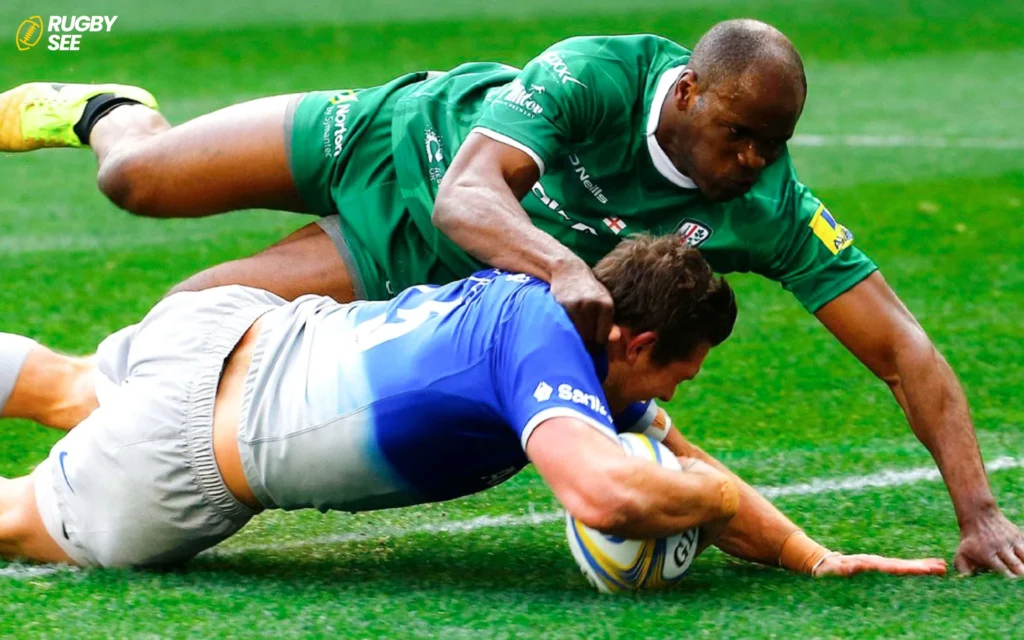When it comes to the rough and tumble world of rugby, one of the most common questions from those unfamiliar with the sport is, “Does rugby have pads?” At first glance, rugby players attacking each other without the bulky protective gear seen in American football can be surprising. This article from Rugbysee examines rugby players’ clothing and focuses on the use of pads and how to balance safety with the sport’s hard-hitting ethos and endurance.
The Basics of Rugby Gear
Rugby is a sport known for its physicality and high-intensity contact. Unlike American football, where players don protective helmets and heavy padding, rugby gear is minimal. The essential kit includes a jersey, shorts, socks, and rugby boots. The most notable difference for newcomers to the sport is the lack of visible, bulky protective gear. However, this doesn’t mean rugby players are without protection.
Protective Gear in Rugby
While it’s true that rugby players do not wear the kind of pads seen in American football, they do have access to protective gear designed to offer some level of safety without compromising the game’s integrity. Here’s a closer look at what constitutes protective gear in rugby:
1. Scrum Caps
Scrum caps are perhaps the most recognizable piece of protective equipment in rugby. These are soft, padded helmets that provide protection for the head, primarily to prevent cuts and abrasions, and to a lesser extent, to mitigate the impact forces during tackles and scrums. They are not, however, designed to prevent concussions.

2. Mouthguards
Mouthguards are a crucial piece of gear for rugby players. They protect against dental injuries and help reduce the risk of concussions. The use of mouthguards is widely encouraged at all levels of play and if you want to know about Using Helmets in Rugby read should rugby players wear helmets.
3. Padded Clothing
Rugby players can wear thin, light padding underneath their jerseys. This padding covers key areas such as the shoulders, chest, and back. Unlike the thick pads worn in football, rugby pads are made from soft, flexible materials designed to absorb impacts without restricting movement.
The Philosophy Behind Minimal Padding
The minimal padding in rugby is not merely a matter of tradition; it’s deeply ingrained in the sport’s philosophy. Rugby emphasizes skill, strategy, and sportsmanship, with a strong focus on tackling technique and fair play. The belief is that excessive padding can encourage more dangerous play by giving players a false sense of invincibility. By requiring players to rely more on technique than on protective gear, rugby promotes a safer approach to tackling and contact.
Safety Measures and Training
Understanding the risks inherent in a contact sport, rugby organizations worldwide have implemented strict safety protocols. These include rigorous training on proper tackling techniques, strict enforcement of rules against dangerous play, and comprehensive concussion management protocols. The emphasis on education and technique is a critical component of rugby’s approach to player safety.
The Future of Protective Gear in Rugby
As sports science advances, so too does the protective gear available to rugby players. Innovations in materials and design continue to offer better protection while still adhering to the sport’s ethos. The future may see even more sophisticated gear that can provide enhanced safety without altering the nature of the game.

Enhancing Player Safety Without Compromising the Game
The ongoing debate about safety in contact sports has led rugby authorities to continuously evaluate and adapt player safety measures. While maintaining the essence of rugby, these adaptations ensure the sport evolves with a keen eye on health and safety advancements. This delicate balance between preserving the game’s integrity and enhancing player safety is where rugby’s approach to protective gear shines.
The Role of Education in Rugby Safety
Education plays a pivotal role in rugby’s safety culture. From the grassroots level to the professional ranks, players are taught the importance of proper technique in tackling, rucking, and engaging in scrums. This education extends beyond the players to coaches, referees, and even spectators, creating a community-wide emphasis on safety. By understanding the game’s demands and the rationale behind minimal padding, everyone involved in rugby contributes to a safer playing environment.
The Impact of Technology on Rugby Gear
Advancements in sports technology have led to significant improvements in the protective gear available to rugby players. Materials that are lightweight, breathable, and capable of absorbing significant impact forces are becoming more common. These technological advancements promise to enhance player safety further while still respecting the game’s traditions. Companies specializing in sports equipment are continuously researching and developing innovative solutions that could redefine what protective gear looks like in rugby and if you want to know about Using Gloves in Rugby read Can Rugby Players Wear Gloves.
Rugby’s Approach to Concussions
Concussion management is a critical area where rugby has focused its attention in recent years. Recognizing the serious nature of brain injuries, rugby organizations have implemented concussion protocols that are among the most advanced in the sports world. These protocols include mandatory rest periods, comprehensive assessment procedures, and graduated return-to-play guidelines. The proactive stance on concussions reflects rugby’s commitment to player welfare.
The Community Aspect of Rugby Safety
Rugby’s culture of respect extends to the way players engage with each other on the field. The sport’s ethos encourages players to look out for their teammates and opponents alike, fostering an environment where safety is a collective responsibility. This community aspect of rugby amplifies the effectiveness of the sport’s safety measures, as players are more likely to adhere to rules and protocols that protect all participants.

Looking Ahead: The Future of Safety in Rugby
As rugby continues to grow globally, the sport’s governing bodies remain vigilant in their pursuit of improved safety measures. Future directions may include further refinements to protective gear, enhanced training programs for injury prevention, and increased use of technology to monitor player health in real-time. The dialogue between players, coaches, medical professionals, and equipment manufacturers is crucial in shaping a future where rugby can be enjoyed with minimized risk.
To answer the question, “Does rugby have pads?” — yes, but not in the way many might think. Rugby’s approach to protective gear is designed to balance player safety with the sport’s core values of courage, discipline, and respect. By focusing on technique, sportsmanship, and minimal protective gear, rugby maintains its unique identity as a tough yet thoughtful game. As we move forward, the rugby community remains committed to evolving safety standards, ensuring that the sport can be enjoyed by future generations with the same passion and intensity that define it today.










